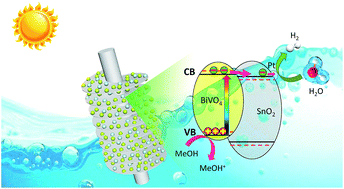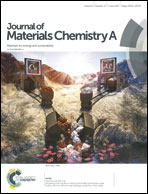Efficient hydrogen evolution under visible light irradiation over BiVO4 quantum dot decorated screw-like SnO2 nanostructures†
Abstract
Nanostructured photocatalysts are often attractive due to their enhanced photocatalytic performance by the quantization effect. In this study, BiVO4 quantum dots were decorated on the surface of screw-like SnO2 nanostructures by successive ionic layer absorption and reaction method. The distinctions from bulk materials and the role of BiVO4 quantum dots were investigated in their function as a water splitting photoanode. It was demonstrated that the band-gap of BiVO4 could increase to 2.6 eV when the particle size decreased to about 5 nm, but the band gap of the bulk was only 2.4 eV. Moreover, the decrease in particle size and the coupling with screw-like SnO2 nanostructures enhanced the photocurrent density up to two times under visible light irradiation. The incident photon to current conversion efficiency also increased up to 13.47% at 400 nm. Furthermore, by depositing Pt as cocatalyst, splitting water into hydrogen was realized on the BiVO4 quantum dot/screw-like SnO2 nanostructures under visible light irradiation, and the generation rate is up to 1.16 μmol h−1 cm−2. The improved photoelectrochemical properties and the enhanced photocatalytic activity for hydrogen evolution are attributed to the effective electron-transfer between BiVO4 quantum dots and screw-like SnO2 nanostructures, and the accordingly prolonged photogenerated charge carrier lifetime, as well as the elevated conduction band bottom level of BiVO4 and SnO2 due to the band-gap widening and energy level realignment.



 Please wait while we load your content...
Please wait while we load your content...